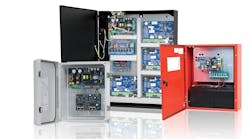One of the really nice innovations in the industry has been the adoption and widespread availability of Power over Ethernet (PoE)-enabled devices, powered over the same Cat 5e (or better) cable carrying Ethernet. It is so easy that the technology can be taken for granted and important considerations overlooked.
First, a little background — the original IEEE 802.3af standard for PoE was approved in 2003 and provided for a minimum of 12.95 watts over a nominal voltage of 48V. The later 802.3at (2009) standard provides for up to 25.5W of power to devices which have been classified by power requirement. PoE is implemented either directly from a PoE-capable Ethernet switch or from a single-port or multi-port intermediate device known as a mid span injector.
This Power Sourcing Equipment (PSE) uses “intelligent discovery” to probe the Powered Device (PD) for its power requirement and delivers what is needed. Not surprisingly, higher levels of power in non-standard implementations have been introduced, particularly since the cable can support higher power levels. One example is Cisco’s Universal Power over Ethernet (UPoE) described in a recent white as providing “60W PoE per switch port to enable new deployment options in next-generation workspace environments.”
Today, annual shipments of PoE switch ports are approaching 100 million — here are five things to consider when deploying PoE.
1. Know your budget – Calculate the total power requirement of your connected devices and plan your power source requirements accordingly.
2. Make the proper PSE selection – Whether a PoE switch or a mid-span injector, the fact that it is advertised to be 802.3at capable does not necessarily mean that full power can be delivered simultaneously on all ports. Look at the total power rating of the PSE equipment to make sure it can handle the projected load.
3. Consider the UPS – One of the great advantages of PoE is that you can dispense with individual power supplies and the time spent wiring those to the PD. Another is the likelihood that an uninterrupted power supply (UPS) is connected to the PSE, providing backup power to both PSE and the devices connected to it. But who is specifying and furnishing the UPS — Security, IT, Facilities? Have they considered the uptime requirements of those security devices relying on the UPS for juice when the lights have gone off? Are the UL requirements for intrusion and access being met under these conditions (remember, there is probably no longer a back-up battery sitting near the PD)? Make sure the UPS is properly sized for the power and time needed.
4. Validate performance – Equipment such as Ideal Industries’ SignalTEK II and others can be tested to validate power available from a power sourcing port — measuring voltage, current and power, as well as those wire airs which are active. These same devices can usually test the cables and connectors to the remote device - always good practice.
5. Monitor the power – As I have written before in this column (STE, April 2011), having the ability to monitor power over the network is really helpful. PoE switches will vary greatly in the capabilities they provide, but some managed switches are available that enable settings for power allocation and priority for individual ports. These, and certain mid-span injectors, may also offer the ability to monitor power consumption on a real-time basis. Take the time to look carefully at the ratings and capabilities of these devices.
Undoubtedly, we will continue to see exciting developments in this Ethernet-meets-Power arena. As the industry has figured out how to salvage coax formerly used to carry analog video to now support Ethernet, we are now seeing that same coax supporting PoE. Pull the analog camera, pop in an IP camera with the necessary PoE transceiver, and you have eliminated the need to pull in new twisted pair. It is likely cheaper than adding an encoder to the analog camera and you get the new feature sets that the IP camera has been endowed with. It could be simplified further if an IP camera manufacturer would build this transceiver into the camera housing (but then it might be mistaken for an analog camera).
Interestingly, the converse of carrying Ethernet over existing DC or AC power wires exists and may be useful in those cases where investment has already been made in a low-voltage infrastructure.
Finally, remember the term EEPoE, which stands for Energy Efficient Power over Ethernet. With approximately 4.5 watts of power wasted on an 802.3at link after 100 meters, new EEPoE technology (see IEEE 802.3az) can cut this link loss by approximately 50 percent, reducing the power requirement of a 24-port switch by up to 50W. As green building technology continues to gain momentum, EEPoE will become significant.
Ray Coulombe is Founder and Managing Director of SecuritySpecifiers.com, enabling interaction with specifiers in the physical security and ITS markets; and Principal Consultant for Gilwell Technology Services. Ray can be reached at [email protected], through LinkedIn or followed on Twitter @RayCoulombe.


